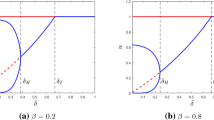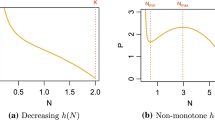Abstract
Many ecological systems exhibit multi-year cycles. In such systems, invasions have a complicated spatiotemporal structure. In particular, it is common for unstable steady states to exist as long-term transients behind the invasion front, a phenomenon known as dynamical stabilisation. We combine absolute stability theory and computation to predict how the width of the stabilised region depends on parameter values. We develop our calculations in the context of a model for a cyclic predator-prey system, in which the invasion front and spatiotemporal oscillations of predators and prey are separated by a region in which the coexistence steady state is dynamically stabilised.















Similar content being viewed by others
References
Dunbar SR (1984) Travelling wave solutions of diffusive Lotka-Volterra equations: a heteroclinic connection in \(\text{ R }^{4}\). Trans Am Math Soc 268:557–594
Dunbar SR (1986) Travelling waves in diffusive predator-prey equations: periodic orbits and point-to-periodic heteroclinic orbits. SIAM J Appl Math 46:1057–1078
Dyczkowski J, Yalden DW (1998) An estimate of the impact of predators on the British field vole Microtus agrestis population. Mammal Rev 28:165–184
Fraile JM, Sabina JC (1989) General conditions for the existence of a critical point-periodic wave front connection for reaction-diffusion systems. Nonlinear Anal Theory Methods Appl 13:767–786
Garvie MR (2007) Finite difference schemes for reaction-diffusion equations modeling predator-prey interactions in MATLAB. Bull Math Biol 69:931–956
Graham IM, Lambin X (2002) The impact of weasel predation on cyclic field-vole survival: the specialist predator hypothesis contradicted. J Anim Ecol 71:946–956
Hellmann JJ, Byers JE, Bierwagen BG, Dukes JS (2008) Five Potential consequences of climate change for invasive species. Cons Biol 22:534–543
King CM (1989) The natural history of weasels and stoats. Christoper Helm, London
Kopell N, Howard LN (1973) Plane wave solutions to reaction-diffusion equations. Stud Appl Math 52:291–328
Korpimäki E, Norrdahl K (1998) Experimental reduction of predators reverses the crash phase of small-rodent cycles. Ecology 79:2448–2455
Korpimäki E, Norrdahl K, Klemola T, Pettersen T, Stenseth NC (2002) Dynamic effects of predators on cyclic voles: field experimentation and model extrapolation. Proc R Soc Lond B 269:991–997
Lotka AJ (1925) Elements of physical biology. Williams and Wilkins, Baltimore
Malchow H, Petrovskii SV (2002) Dynamical stabilization of an unstable equilibrium in chemical and biological systems. Math Comput Model 36:307–319
Malchow H, Petrovskii SV, Venturino E (2008) Spatiotemporal patterns in ecology and epidemiology. Chapman and Hall/CRC, Boca Raton
Matsumura C, Yokoyama Y, Washitani I (2004) Invasion status and potential ecological impacts of an invasive alien bumblebee, Bombus Terrestris L. (Hymenoptera: Apidae) naturalized in Southern Hokkaido. Jpn Glob Environ Res 8:51–66
May RM, Mclean AR (2007) Theoretical ecology: principles and applications. Oxford University Press, Oxford
McDonald RA, Harris S (2002) Population biology of stoats Mustela erminea and weasels Mustela nivalis on game estates in Great Britain. J Appl Ecol 39(5):793–805
Norrdahl K, Korpimäki E (2002) Changes in population structure and reproduction during a 3-yr population cycle of voles. OIKOS 96(2):331–345
Nozaki K, Bekki N (1983) Pattern selection and spatiotemporal transition to Chaos in the Ginzburg-Landau equation. Phys Rev Lett 51:2171–2174
Oli MK (2003) Population cycles of small rodents are caused by specialist predators: or are they? Trends Ecol Evol 18:105–107
Owen MR, Lewis MA (2001) How predation can slow, stop or reverse a prey invasion. Bull Math Biol 63:655–684
Petrovskii SV, Vinogradov ME, Morozov AY (1998) Spatial-temporal dynamics of a localized populational “burst” in a distributed prey-predator system. Okeanologiya 38:881–890
Petrovskii SV, Vinogradov ME, Morozov AY (2000) Spatial-temporal dynamics of a localized populational “burst” in a distributed prey-predator system. Okeanologiya 38:37–51
Petrovskii S, Kawasaki K, Takasu F, Shigesada N (2001) Diffusive waves, dynamical stabilization and spatio-temporal chaos in a community of three competitive species. Jpn J Indust Appl Math 18:459–481
Rademacher JDM, Sandstede B, Scheel A (2007) Computing absolute and essential spectra using continuation. Phys D 229:166–183
Reynolds JJH, Massey FP, Lambin X, Reidinger S, Sherratt JA, Smith MJ, White A, Hartley SE (2012) Delayed induced silica defences in grasses and their potential for destabilising herbivore population dynamics. Oecologia 170:445–456
Rosenzweig ML, Macarthur RH (1963) Graphical representation and stability conditions of predator-prey interactions. Am Natur 97:209–223
Sandstede B, Scheel A (2000) Absolute and convective instabilities of waves on unbounded and large bounded domains. Phys D 145:233–277
Sherratt JA (2001) Periodic travelling waves in cyclic predator-prey systems. Ecol Lett 4:30–37
Sherratt JA, Smith MJ (2008) Periodic travelling waves in cyclic populations: field studies and reaction-diffusion models. J R Soc Interface 5:483–505
Sherratt JA, Eagan BT, Lewis MA (1997) Oscillations and chaos behind predator-prey invasion: mathematical artifact or ecological reality. Philos Trans R Soc Lond B 352:21–38
Sherratt TN, Lambin X, Petty SJ, MacKinnon JL, Coles CF, Thomas CJ (2000) Application of coupled oscillator models to understand extensive synchrony domains and travelling waves in populations of the field vole in Kielder forest, UK. J Appl Ecol 37(suppl. 1):148–158
Sherratt JA, Lambin X, Thomas CJ, Sherratt TN (2002) Generation of periodic waves by landscape features in cyclic predator-prey systems. Proc R Soc Lond B 269:327–334
Sherratt JA, Smith MJ, Rademacher JDM (2009) Locating the transition from periodic oscillations to spatiotemporal chaos in the wake of invasion. PNAS 106:10890–10895
Smith MJ, Sherratt JA (2009) Propagating fronts in the complex Ginzburg-Landau equation generate fixed-width bands of plane waves. Phys Rev E 80 (Art. No. 046209)
Smith MJ, Rademacher JDM, Sherratt JA (2009) Absolute stability of wavetrains can explain spatiotemporal dynamics in reaction-diffusion systems of Lambda-Omega type. SIAM J Appl Dyn Syst 8:1136–1159
Tokarska-Guzik B, Brock JH, Brundu G, Child L, Daehler CC, Pysek P (2008) Plant invasions: human perception, ecological impacts and management. Backhuys, Leiden
Turchin P (2003) Complex population dynamics: a theoretical/empirical synthesis. Princeton University Press, Princeton
Turchin P, Hanski I (1997) An empirically based model for lattitudinal gradient in vole population dynamics. Am Nat 149:842–874
van Saarloos W (2003) Front propagation into unstable states. Phys Rep 386:29–222
Volterra V (1926) Variazione fluttuazioni del numero d’individui in specie animali conviventi. Mem Acad Lincei 2:31–113 (Translation in an appendix to Chapman RN (1931) J Anim Ecol 409–448)
Author information
Authors and Affiliations
Corresponding author
Rights and permissions
About this article
Cite this article
Dagbovie, A.S., Sherratt, J.A. Absolute stability and dynamical stabilisation in predator-prey systems. J. Math. Biol. 68, 1403–1421 (2014). https://doi.org/10.1007/s00285-013-0672-8
Received:
Revised:
Published:
Issue Date:
DOI: https://doi.org/10.1007/s00285-013-0672-8




